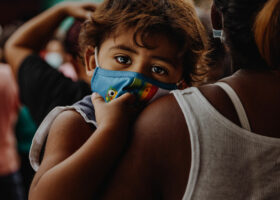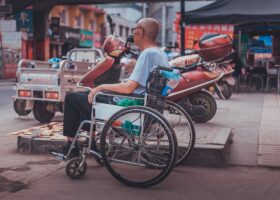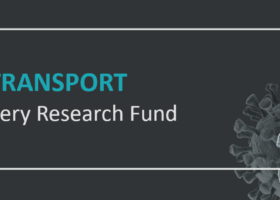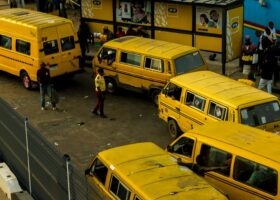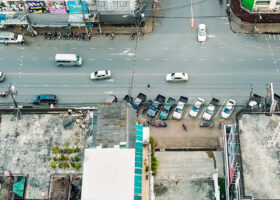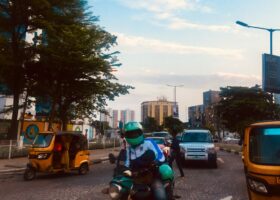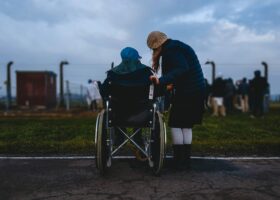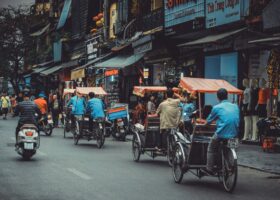Overview
While everyone is affected by the global pandemic, older people and those with disabilities are often disproportionately affected by the impact of the current restrictions on their mobility, health and wellbeing as well as on their access to information in formats appropriate to them (e.g. sign language, lip reading).
The webinar draws on current experiences from colleagues around the world working in this field and draws together thoughts on key issues and useful initiatives in place, or planned, to address them.
Publications with the same themes
Publications with the same study countries
Related news & events
News
Blog
News
News
News
Blog
News
Blog
Blog
PDF content (text-only)
INCLUSIVE ACCESS NETWORK WEBINAR – SUMMARY NOTES The Impact of COVID-19 on the Mobility of Disabled and Vulnerable People 23rd April 2020 Topic While everyone is affected by the global pandemic, older people and those with disabilities are often disproportionately affected by the impact of the current restrictions on their mobility, health and wellbeing as well as on their access to information in formats appropriate to them (e.g. sign language, lip reading). The webinar draws on current experiences from colleagues around the world working in this field and draws together thoughts on key issues and useful initiatives in place, or planned, to address them. Presentations Introduction: Louise Cathro, HVT Programme Manager The High Volume Transport Programme (HVT) is a 5-year applied research programme funded by DFID focused on national and regional transport corridors and within cities in low-income countries in Africa and South Asia. The HVT Programme is pleased to present this first webinar featuring our Inclusive Access Network. The Inclusive Access Network originates from the panel members that participated in the Foresight Session on Disability Inclusive Road Transport held at the PIARC World Road Congress in October 2019. The session was organised by the HVT Programme on behalf of the UK Departments of Transport and International Development. The Session received the award for Best Session of the Congress, as voted for by the delegates. The Network members are all experts in the field of inclusive mobility and social inclusion and originate from a wide variety of organisations including multilateral agencies, academia and civil society and from countries ranging from China to Mexico. Update from the High Volume Transport Applied Research Programme (HVT): Bernard Obika, Team Leader Inclusion is one of two main pillars for the HVT programme. Over the past year we have supported DFID's efforts in this area through a number of initiatives. As well as organising the Foresight session in Abu Dhabi: • We have published the Disability Inclusive Public Transport Policy Brief – a document intended for policy makers; • We will shortly be revising ORN21, a document that helps technical experts design transport infrastructure that is inclusive; • We have called for proposals for research suppliers to provide us with innovative research projects that can improve the inclusivity of transport systems in the global south; and • We have several other inclusive access initiatives in addition to making sure that inclusion is integral to all we do in other areas. As the COVID-19 pandemic takes hold in low-income countries, with transport systems being a primary mode of infection, we need to understand the impact on the most vulnerable and people with disabilities in particular. What are the inclusion issues and who is addressing those issues now and post-COVID-19? HVT has just published a short paper calling for co-ordinated action by global transport sector key stakeholders on COVID-19. This publication is based on the findings of work we have done over the past few weeks to establish "who is doing what" in the transport sector in response to the pandemic. That study, regrettably, shows that no-one is paying particular attention to inclusive access despite the many important issues COVID-19 raises for inclusion. Update from of the Department for International Development (DFID): Penny Innes, Head of the Disability Inclusion Team Brief overview of DFID activities in relation to the implication of COVID-19 for people with disabilities: • DFID is shifting much of its work to COVID-19 and many of its programmes are being redirected towards fighting the pandemic. • DFID is gathering evidence on the impact on people with disabilities. • People with disabilities are more likely to contract the virus. Social distancing is unfeasible if you rely on a caregiver. They are also more likely to develop serious complications from those affected by secondary impacts – lower access to healthcare etc. • It is important to involve people with disabilities in developing appropriate responses, preferably in a leadership role. • A key issue is for communication in appropriate formats to meet the needs of people with impaired vision/ hearing, intellectual impairment etc. • DFID is working on disaggregating data so the picture of the impact on people with disabilities can become clearer. The approach of the World Bank: Charlotte McClain-Nhlapo, Global Disability Advisor • Many people with disabilities are not able to access critical medical appointments. Travel restrictions need consistent messages that can be understood by all – particular concerns for those with intellectual and developmental disabilities. • The World Bank has introduced a requirement that by 2025, all urban mobility projects must be disability inclusive. They are also working on 3 projects: Sustainable mobility for all; Enhanced road safety outcomes; and Disability resulting from road crashes (funded by DFID). Additional slides from Charlotte included at the end of this summary. Global snapshots Subhash Vashishth, Svayam, India • India is observing a lockdown with only essential services open. The level of lockdown varies depending on the level of virus impact with relaxing of restrictions in some areas to allow the opening of all standalone shops. Strict social distancing must still be observed. • Government has issued 'Comprehensive Disability Inclusive Guidelines' for implementation by all States and Union Territories to be followed during the COVID19 lockdown. • Public transport services are closed however, 25% of buses are operating purely to transport key workers involved in essential services. • Masks are mandatory for all when you step out of home. • Delhi has established a large number of food centres for migrant labourers that are now unemployed. All residents eligible for subsidised dry rations (grains), are also given a fixed additional quantity per person by the state through a well-established public distribution system. State Commissioners for persons with disabilities have been declared as the nodal authority to cater to the specific needs of persons with disabilities. • Blood donation is organised to keep the blood bank full for the transfusion needs of people with blood disorders. In addition, all hospitals have created isolated COVID-19 centres. In Delhi, five major hospitals are COVID-19 only hospitals. • Curfew passes are issued online for essential services; a category for 'Caregiver of person with disabilities' has been added to ensure support needs continue. • Challenges: No accessible taxis in most states. Disabled people have to rely on ambulances to get to hospitals, personal vehicles or some NGO-run special vehicles. Facemasks are impacting the ability of deaf people to communicate. Some NGOs have promoted masks that are transparent near the lips but that is not the norm when everyone is asked to use homemade washable cloth masks. People with cerebral palsy, spinal injuries, polio survivors and those with other mobility challenges suddenly have no access to therapy services and many have reported developing stiff joints to helplines. Phone repair shops are closed, and many disabled people face problems with nonfunctioning phones. While most education institutions are providing online classes, the education of disabled students is affected as the provisions are not friendly to disabled students particularly with hearing and intellectual challenges. Amin Amir Andani, NOWPDP, Pakistan • To date, around 10,500 infections, 220 deaths, and 2300 recoveries related to COVID-19 have been recorded. • Airlines, railways and intercity buses and ride-hailing services are non-operational. • Only private transportation, grocery or medicine deliveries, and few rickshaws are visible on the road. • People with disabilities are facing issues particularly in relation to medical needs due to a lack of public transportation. • Welfare activities: Ehsaas Emergency Cash Programme pays 12,000 Pakistani Rupees to 12 million families and this is accessible to people with disabilities who access the funds from mobile shops. Door-to-door ration distribution by bike sharing services. Telehealth services are free for people with disabilities. NOWPDP has taken responsibility of 3,500 people with disabilities and their families for the next 3 months (ration, skills and livelihoods). Shifted training to online media which has resulted in better attendance compared with physical classes. Amanda Gibberd, Department of Transport, South Africa • Poverty and difficulty with access to food are also issues for South Africa. Overcrowding in townships and lack of access to water (for handwashing) are also causing anger. • All non-essential travel is restricted, and government departments are working together to get food and hygiene equipment into people's homes. • South Africa has large network of mobile phones so use of WhatsApp is key for communication. • People with learning disabilities and autism are badly affected by the lockdown; support is being given on case by case basis. • There is a financial package to stimulate the economy, including social grants for people with disabilities/ older people. • There is a need for international guidance on transport as a transmitter of the virus and greater clarity on issues such as the effectiveness of wearing masks. Timeline of the South African response to COVID-19 attached at the end of this summary. Janett Jimenez Santos, Can Lah, Mexico • For a number of reasons, Mexican citizens distrust their government; some think COVID-19 pandemic is a fraud while others are afraid. • Information has been a key factor; transport authorities have been creative in giving information for people with different levels of education (e.g. with drawings, comics, alien characters, etc.) considering cultural aspects to make sure the right message is sent. Information is provided in different formats (visual, audio, videos, etc.). • Gradual actions have been taken for public transport, implementing tighter measures one step at a time. All transport systems in Mexico City and its metropolitan area are in constant communication to ensure consistency in approach and information provided to passengers. • Strategy implemented to reduce mobility gradually - closing metro stations that are not critical, reducing the passenger capacity of buses (by 50%) to allow social distancing however, this has resulted in increased costs to travel. Local authorities must implement their own programs in coordination with different stakeholders. • Regulations introduced for sanitary measures in public transport for the future for the protection of bus drivers (plastic screen in the cabin, gloves and face masks), operational aspects. • Disposal of protective equipment has resulted in a large amount of trash. • Ramp vehicles have been successful to assist people with medical issues to access health services. International standards for accessible vehicles are needed as well as an economic model for effective systems and protocols for accessible transportation. Mohammed Youssef - The EquallyAble Foundation, USA • Created a COVID-19 Disability Relief Initiative to provide food and essential relief, physical and mental tele-health support, virtual and digital empowerment and crisis analysis. • Working with Easter Seals, agreed a grant of US$25k towards COVID-19 Disability Relief Fund created to support over 1 million people with disabilities in the USA. • Supporting 6000 individuals with disabilities globally with food for a month. • Available to assist partners in developing countries. Discussion Tom Rickert, Access Exchange International (AEI) AEI had drawn up advice for people with disabilities in dealing with COVID-19 – posted on their website https://www.globalride-sf.org/COVID/1.Transport.disability.coronavirus.pdf. Vital to get practical information out to people and important to involve transport operators in discussion of what could/should be done. Further information from AEI attached at the end of this summary. Charlotte McClain-Nhlapo, World Bank Community engagement, which has traditionally been face to face, is excluding those without access to technology. This will affect the poorest most acutely as over 30% of the poorest people in the world are without access to a phone. Summary Ann Frye, Moderator The contributions to the webinar had provided valuable insights into way in which different countries are tackling the pandemic both in general and in the context of access/mobility for people with disabilities in particular. There are considerable differences in the approaches being taken and, in particular, of the level of co-ordination between different levels of Government and other public and private sector providers. It is also clear that no-one was well prepared and that issues facing people with disabilities had not been foreseen or prepared for. Three key themes to emerge from the discussion were: 1. Access: most public transport has stopped so getting food and medication for people with disabilities is key – systems are generally being put in place to deliver support in cash or in kind, but problems still exist for many. Social distancing is impossible for those people who need support with their care needs. 2. Technology: Mobile/ cell phones in particular are playing a vital role in helping people with disabilities to stay in touch and to identify their needs and get help with food and medication and to keep people informed. While some countries have extensive network coverage and phone ownership is high, in others there are large numbers of vulnerable people without access to technology who are still struggling. 3. Communication: Putting out Government and operational information in formats that work for people with vision or hearing impairments as well as for those with intellectual or cognitive issues is as important in public transport as elsewhere. The quality and consistency of information varies greatly currently both within and between countries.




